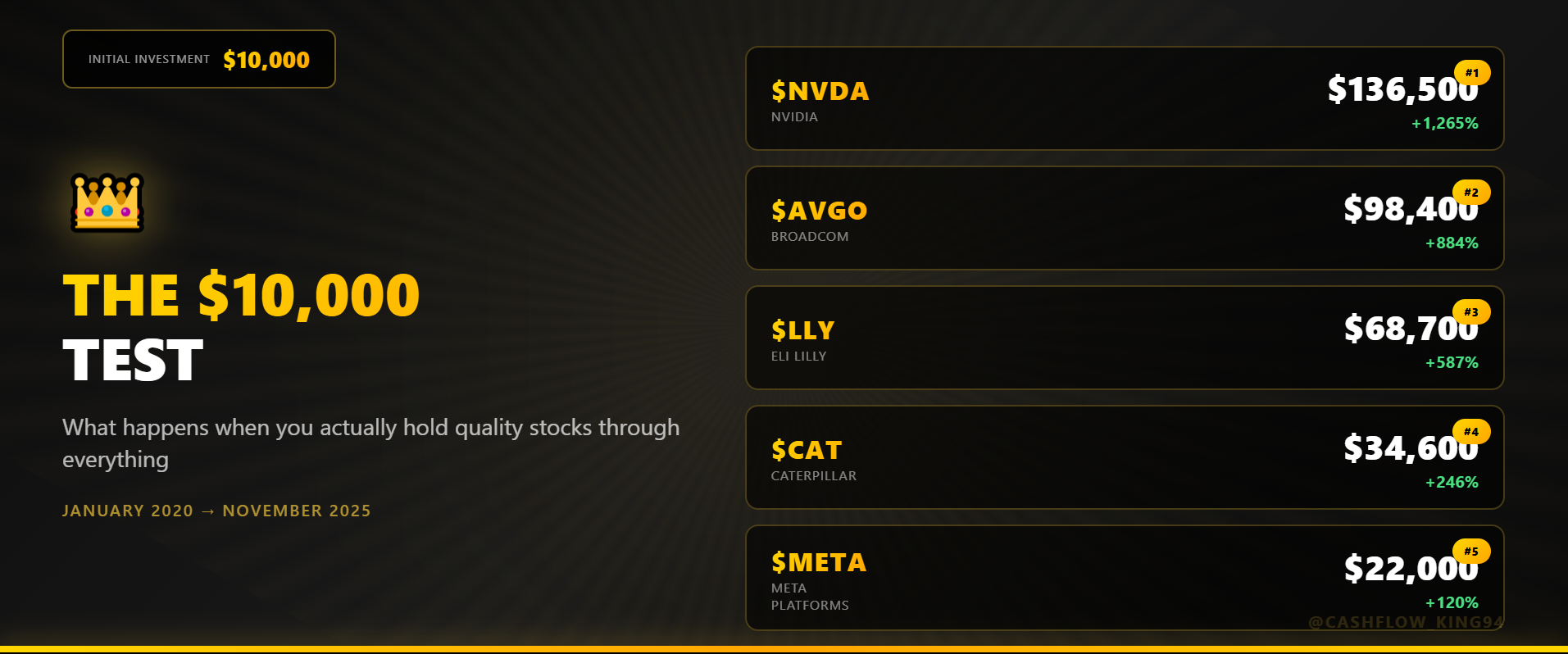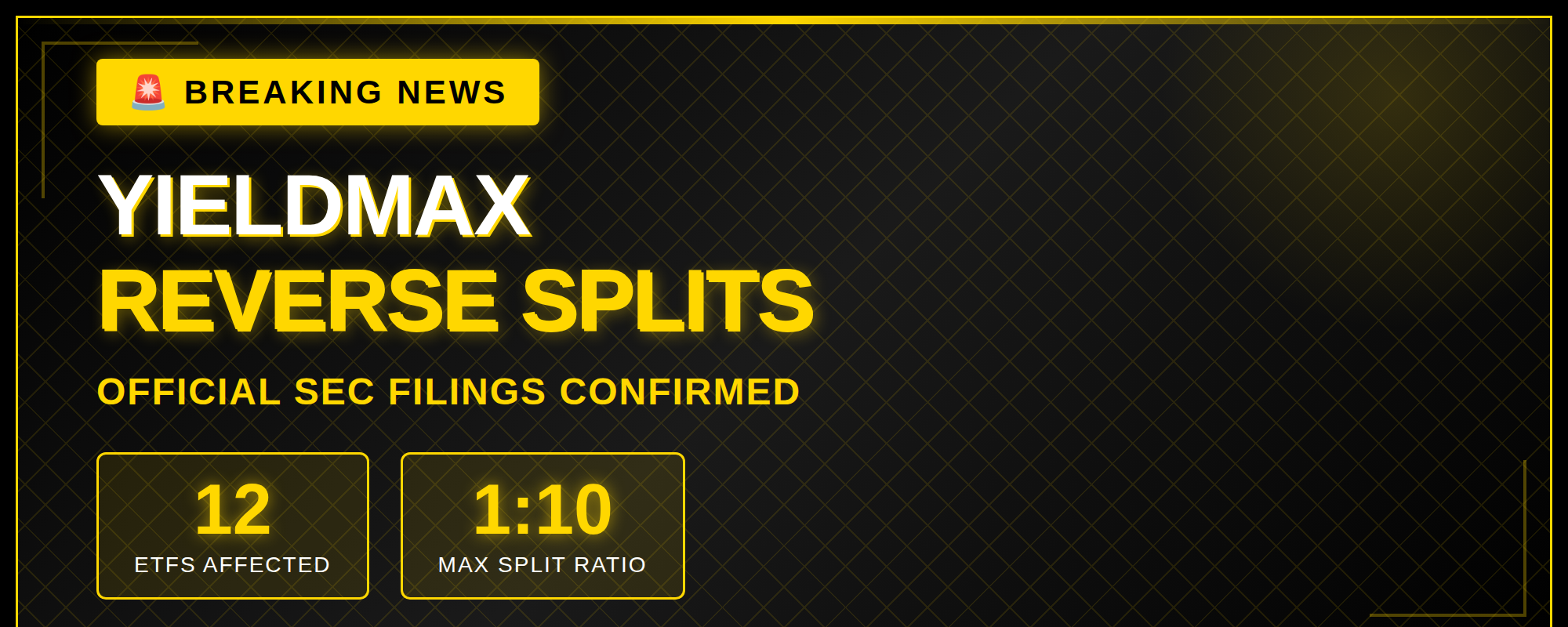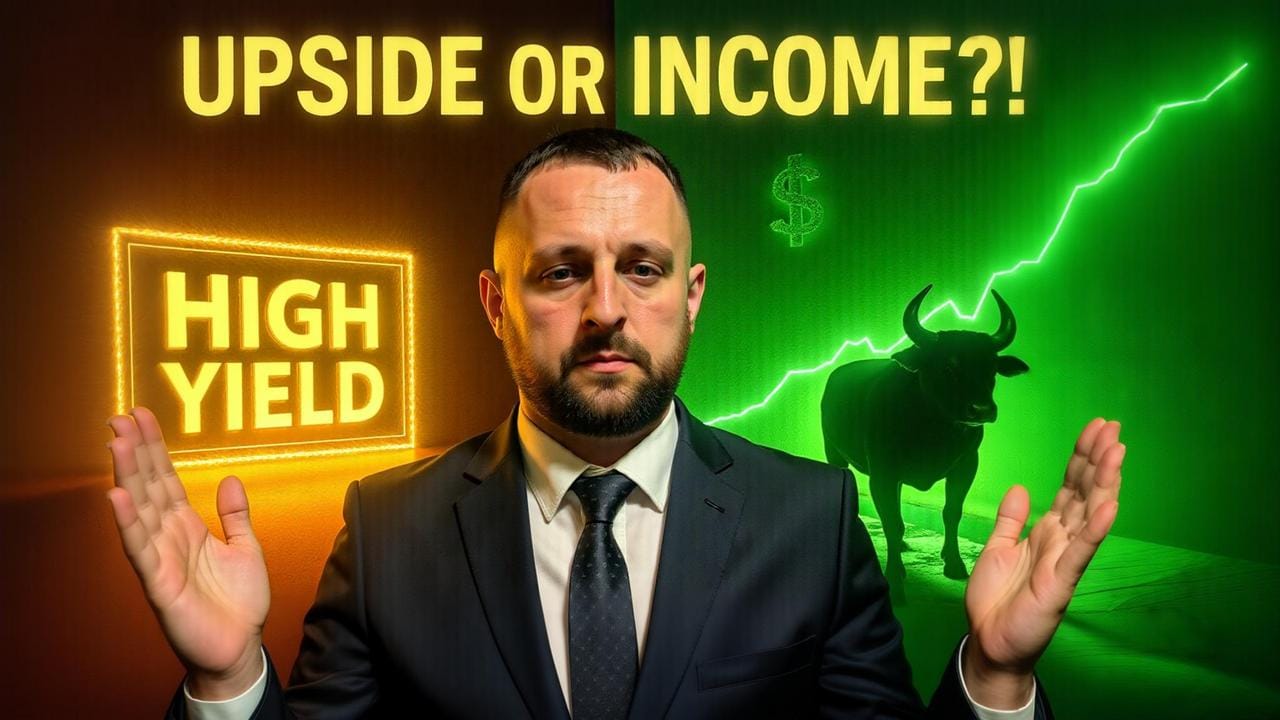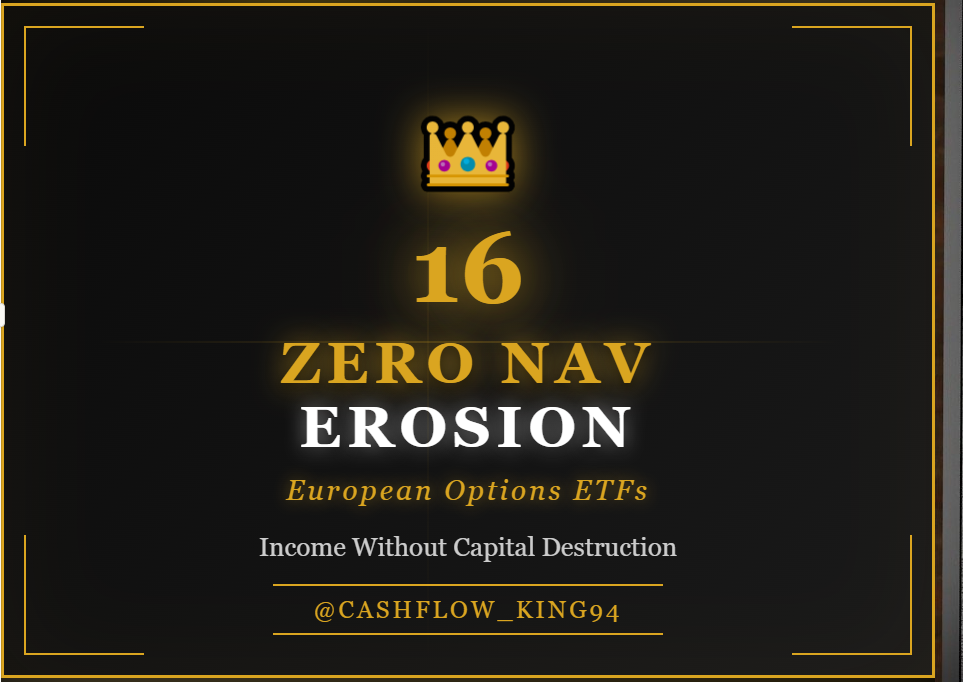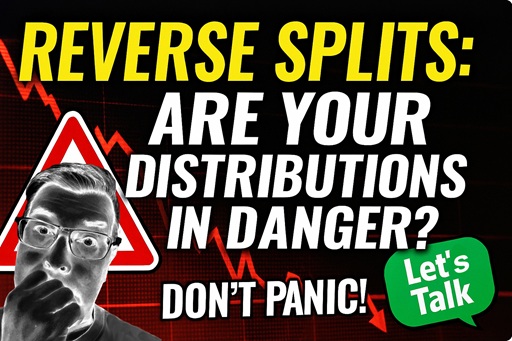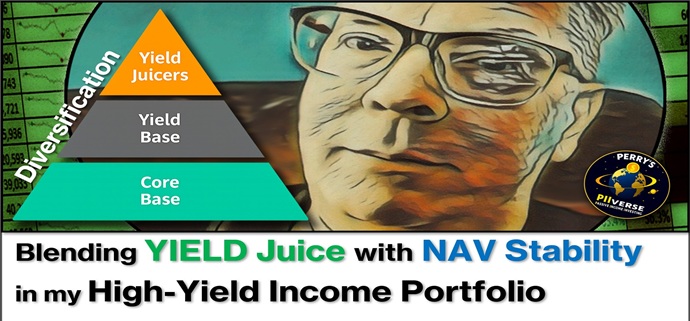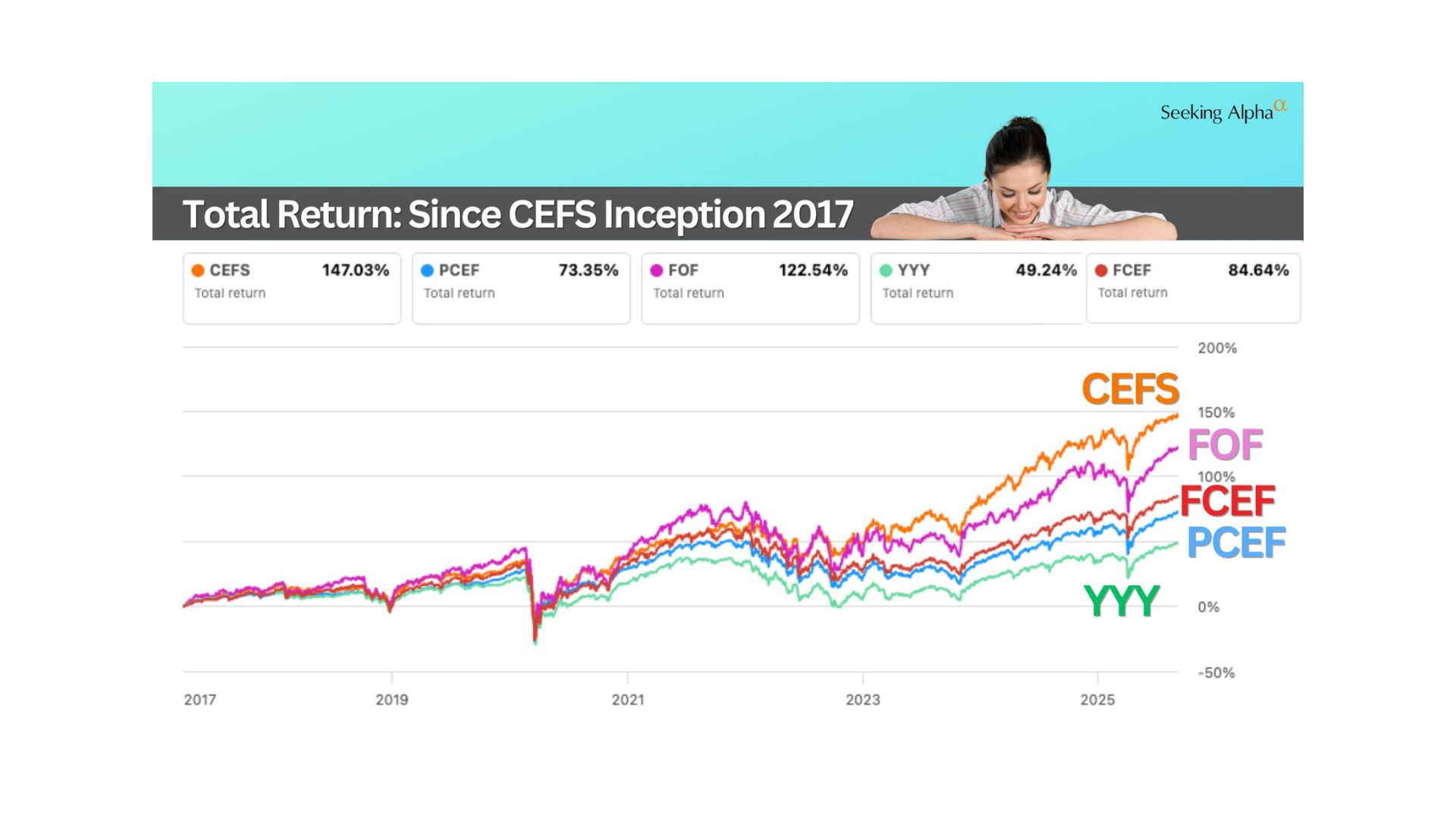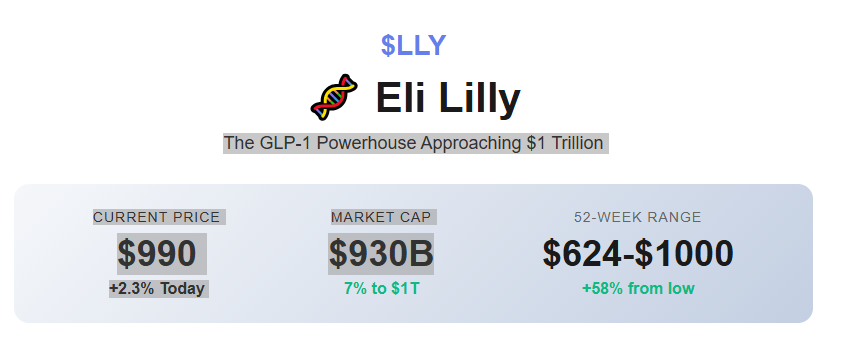A deep dive into the power of long-term investing 
Let me ask you a question that might make you uncomfortable:
If you had invested $10,000 in January 2020 and simply held through everything – the pandemic crash, the meme stock mania, the 2022 bear market, the AI boom – where would you be today?
Most people don't want to answer this question because it forces them to confront their own behavior.
The panic selling.
The FOMO buying. The constant portfolio tweaking that destroys returns.
But let's look at what happens when you make the "boring" choice: Buy quality companies, reinvest dividends, and hold for the long term.
THE RESULTS: $10,000 INVESTED IN JANUARY 2020
Here's what your $10,000 would be worth today (November 2025) if you had invested in these five quality companies and reinvested all dividends:
 $NVDA: $136,500 (+1,265%)
$NVDA: $136,500 (+1,265%)
 $LLY: $68,700 (+587%)
$LLY: $68,700 (+587%)
 $AVGO: $98,400 (+884%)
$AVGO: $98,400 (+884%)
 $CAT: $34,600 (+246%)
$CAT: $34,600 (+246%)
 $META: $22,000 (+120%)
$META: $22,000 (+120%)
That's less than 6 years. Not 20. Not 30. Less than 6 years.
THE TIMELINE: WHAT YOU HAD TO ENDURE
Let's be very clear: These returns didn't come easy. You had to live through:
March 2020: The Pandemic Crash
Market dropped 34% in a month
NVDA fell from $62 to $37
META crashed from $224 to $146
Your $10,000 became $6,600
Everyone screamed "sell everything!" The world was ending.
The people who held? They're the ones with the returns above.
2021: The Meme Stock Mania
While your quality stocks were grinding higher, your friends were making 500% on GameStop in a week.
AMC was "going to the moon." Crypto was printing millionaires overnight.
You felt like an idiot for holding "boring" companies like Caterpillar and Broadcom.
But you held.
2022: The Bear Market
The Fed raised rates. Tech crashed. META dropped 76% from its peak. NVDA was cut in half.
"AI is dead," they said. "Tech is over," they proclaimed.
You watched your portfolio bleed red for months.
But you held.
2023-2025: The Recovery and Boom
AI suddenly became the hottest thing in the world. NVDA went parabolic. LLY's GLP-1 drugs became a phenomenon.
Your patience was finally rewarded.
This is how wealth is built. Not by trading. By HOLDING.
WHY NVIDIA DOMINATED: THE 1,265% STORY
In January 2020, NVDA was trading around $60 per share (split-adjusted). Most people saw it as "just a gaming company."
But here's what the smart money saw:
 Leadership in GPU technology
Leadership in GPU technology
 Expanding into data centers
Expanding into data centers
 Early positioning in AI infrastructure
Early positioning in AI infrastructure
 A CEO who understood where technology was going
A CEO who understood where technology was going
When the AI boom hit in 2023, NVDA wasn't scrambling to catch up. They were already there. They had been building the infrastructure for a decade.
The lesson? Find companies that are building the future before everyone else notices.
ELI LILLY: THE 587% SURPRISE
In 2020, LLY was a solid pharmaceutical company. Good dividend. Stable business. Nothing sexy.
Then came the GLP-1 revolution.
Mounjaro and Zepbound became blockbuster drugs almost overnight. The obesity treatment market exploded from niche to mainstream.
But this didn't happen by accident. LLY had been researching and developing these drugs for YEARS.
Your 587% return? That's what happens when you invest in companies innovating in massive addressable markets.
BROADCOM: THE 884% "BORING" WINNER
While everyone obsessed over NVDA's AI dominance, Broadcom quietly became one of the best-performing stocks.
884% return. Nearly 10x your money.
And most retail investors have never bought a Broadcom product. Many don't even know what Broadcom does.
Here's what they do: They make the infrastructure that makes everything else work. Networking chips. Data center solutions. Enterprise software.
Not sexy. Not exciting. Just absolutely critical to the functioning of the digital economy.
While everyone chased hot AI stocks, Broadcom was selling shovels to the gold miners.
The lesson? Sometimes the best investments are the "boring" companies that enable the exciting stuff.
CATERPILLAR: THE "WORST" PERFORMER
Let's talk about the "worst" performer on this list: Caterpillar.
"Only" 246% return. "Only" tripling your money in 6 years.
CAT has increased its dividend for 32 consecutive years. Through recessions, booms, crashes, and recoveries.
This is what stability looks like. This is what quality looks like.
When markets crashed in 2020, CAT kept paying. When inflation surged in 2022, CAT raised their dividend. When infrastructure spending increased, CAT was positioned to benefit.
246% might not be as exciting as NVDA's 1,265%. But it's a hell of a lot better than the -30% most people experienced by panic selling and FOMO buying.
META: THE COMEBACK STORY
In 2022, META was left for dead.
The metaverse was a disaster. Apple's iOS changes destroyed their ad business. TikTok competition was killing engagement. Zuckerberg was public enemy #1.
The stock crashed 76% from its peak.
But here's what happened:
META cut costs aggressively
Refocused on core business
Invested heavily in AI
Proved Facebook and Instagram still print money
Even after that disaster 2022, if you held from January 2020, you still MORE THAN DOUBLED your money.
This is why you don't panic sell quality companies just because they have a bad year.
THE POWER OF DIVIDEND REINVESTMENT
Here's what most people miss: The returns above include reinvested dividends.
Let me show you why this matters using Caterpillar as an example:
Without dividend reinvestment:Stock appreciated + $2,400 in dividend cash payments over 6 years.
With dividend reinvestment:Every quarterly dividend bought more shares. Those shares paid dividends. Which bought more shares.
This "dividend snowball" effect added THOUSANDS of dollars to your final return.
Over a 6-year period, this might seem like a small difference. But extend this to 20-30 years? The difference becomes generational wealth.
WHAT THESE RETURNS ACTUALLY MEAN
Let's put these numbers in real-world context:
$10,000 in credit card debt at 20% APR:You would have paid $12,000+ in interest over 6 years. Got poorer.
$10,000 in savings account at 2% APR:You would have $11,265 today. Barely kept pace with inflation. Got poorer.
$10,000 in ONE of these quality stocks:You would have $22,000 to $136,500. Built real wealth.
The opportunity cost of not investing is staggering.
THE MINDSET THAT MADE THIS POSSIBLE
Here's what separated the winners from the losers:
Winners thought:
"This company has strong fundamentals"
"The thesis hasn't changed"
"This is a buying opportunity"
"I'm thinking in decades, not days"
Losers thought:
"The market is crashing, I need to sell"
"This stock is down 50%, it's broken"
"I'll buy back in when things stabilize"
"I need to take profits before it's too late"
The mindset difference is everything.
THE HARD TRUTH ABOUT HOLDING
Let me be brutally honest: Most people reading this couldn't have held through what happened over the past 6 years.
Not because they're stupid. Not because they're weak.
But because holding through 50%+ drawdowns is psychologically torturous when it's your real money on the line.
When your $10,000 becomes $5,000 and everyone is telling you to sell, it takes enormous conviction to hold.
When your friends are getting rich on meme stocks and you're holding "boring" quality companies, it takes discipline to stay the course.
When the news is screaming that the world is ending, it takes courage to keep investing.
That's why these returns exist. They're compensation for psychological pain.
THE STRATEGY THAT WORKS
So how do you actually capture these returns? Here's the framework:
1. Invest in Quality Companies
Look for:
Strong competitive advantages
Consistent profitability
Good management
Large addressable markets
History of innovation
2. Reinvest All Dividends
Don't take the cash. Use every dividend to buy more shares. The compounding effect is massive over time.
3. Hold Through Volatility
Markets will crash. Your stocks will drop 50%. The news will be terrifying. Hold anyway.
4. Add During Dips
When everyone is panicking, that's when you deploy more capital. The best buying opportunities come during maximum fear.
5. Think in Decades
6 years is actually SHORT-TERM in the stock market. The real magic happens over 20-30 years. These 6-year returns? They're just the beginning.
WHAT ABOUT THE NEXT 6 YEARS?
Here's the question everyone wants answered: "What should I buy NOW for the next 6 years?"
I can't predict the future. Nobody can.
But I can tell you this: The principles that worked from 2020-2025 will work from 2025-2031.
Find quality companies. Buy them at reasonable prices. Reinvest dividends. Hold through the chaos.
Will it be NVDA again? Maybe. Maybe not.
Will it be something nobody is talking about right now? Probably.
But if you follow the process, you'll capture the returns regardless of which specific stocks perform best.
THE BOTTOM LINE
$10,000 invested in quality companies in January 2020 could be worth anywhere from $22,000 to $136,500 today.
That's the difference between:
Working until you're 70 vs retiring early
Generational wealth vs living paycheck to paycheck
Financial freedom vs financial stress
And it didn't require:
 Day trading
Day trading
 Options strategies
Options strategies
 Crypto gambling
Crypto gambling
 Meme stock YOLO plays
Meme stock YOLO plays
Just quality companies, reinvested dividends, and patience.
The market rewards those who can endure short-term pain for long-term gain.
The question is: Are you willing to endure it?
YOUR MOVE
The next 6 years are going to happen whether you invest or not.
You can spend them:
 Panic buying and selling
Panic buying and selling
 Chasing the hot stock of the week
Chasing the hot stock of the week
 Sitting in cash earning nothing
Sitting in cash earning nothing
 Making excuses
Making excuses
Or you can:
 Find quality companies
Find quality companies
 Buy them consistently
Buy them consistently
 Reinvest dividends
Reinvest dividends
 Hold for the long term
Hold for the long term
In November 2031, you'll look back at November 2025 and either think:
"I'm so glad I started investing back then"
or
"I wish I had started investing back then"
Your choice.
Time in the market beats timing the market. Every. Single. Time.
Stay convicted. Stay disciplined. Build wealth 
If you found this valuable, retweet the first post and follow for more real-world investing insights.
The data doesn't lie. The strategy works. The question is: Will you execute?




